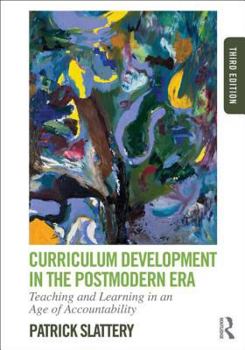Curriculum Development in the Postmodern Era: Teaching and Learning in an Age of Accountability
Select Format
Select Condition 
Book Overview
This landmark text was one of the first to introduce and analyze contemporary concepts of curriculum that emerged from the Reconceptualization of curriculum studies in the 1970s and 1980s. This new edition brings readers up to date on the major research themes (postmodernism, ecological, hermeneutics, aesthetics and arts-based research, race, class, gender, sexuality, and classroom practices) within the historical development of the field from...
Format:Paperback
Language:English
ISBN:0415808561
ISBN13:9780415808569
Release Date:August 2012
Publisher:Routledge
Length:376 Pages
Weight:1.25 lbs.
Dimensions:0.8" x 6.9" x 9.8"
Customer Reviews
1 rating
A good introduction to postmodern curriculum thought
Published by Thriftbooks.com User , 25 years ago
. Back when most of the readers of this review went to college to learn to be teachers, we were good girls and good boys. We took our required courses and we studied pedagogy. We learned about Maslow's hierarchy, about Ausubel's anticipatory set, about Skinner's rewards and punishments, Bloom's taxonomy of educational objectives, Piaget's and Erikson's stages of development. We became certified. We entered our schools in the morning and we came home at night to our families. If we weren't teaching in our home town, our students were themselves from families, communities, cultures, that sometimes confused us. But if we didn't have knowledge of the students' families, communities, and culture, we didn't mind, for our training in the subjects we taught and our training in how to teach those subject matters told us that we were to be objective, that certain purposeful goals and plans would work to teach all students, if only we filled out our behavioral lesson plans and had enough classroom management. We believed fervently that the world of the classroom was indeed manageable, and all students could be taught no matter what by the methods of the pedagogical methodologists- the Jerome Bruner of the Woods Hole Conference (1960), who said we should teach through the structure of the discipline; the National Science Foundation who said we should engage in the new math and in MACOS (Man: A Course of Study); Benjamin Bloom, and his colleagues (1969), who made taxonomies of behavioristic objectives of learning in the affective and the cognitive domains, and who went on to invent a system called "mastery learning," which said we could "teacher proof" the curriculum so that it could be "delivered" to all students in a certain amount of time; Robert Gagné (1974) , who invented a "system approach" to teaching and learning. "The Curriculum," we had been taught, is a written document with a certain selection of materials to be read or covered, a scope and a sequence, and defined goals. This view is based on what is called the Tyler Rationale, based on the work of Ralph Tyler, who in 1949 stated four purposes for curriculum: 1. What educational purposes should the school seek to attain? [objectives]; 2. What educational experiences can be provided that are likely to attain these purposes? [design]; 3. How can these educational experiences be effectively organized? [scope and sequence]; 4. How can we determine that these purposes are being attained? [evaluation]. We came to believe that we, as good girls and boys, would be good curriculum people if we were organized and followed the systems and suggestions of these gurus. But when we got home from those schools, when we went to lunch with our friends, when we confessed to each other that our well-laid plans were not working. Or at least not the way we thought they would. In many of our schools, chaos reigned. The leaders weren't leading; the students w




